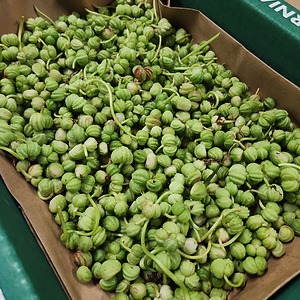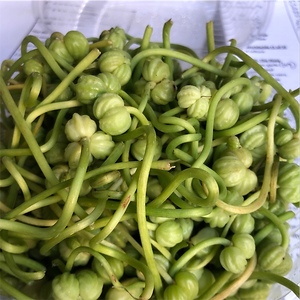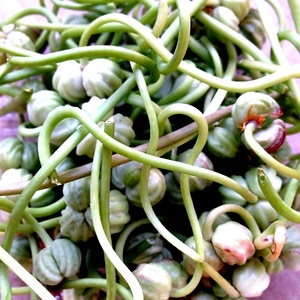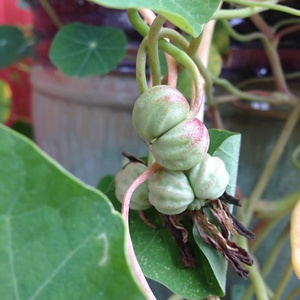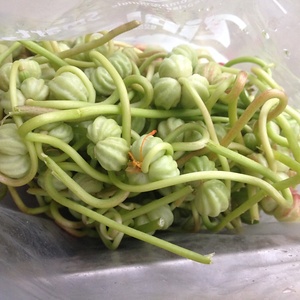


Nasturtium Pods
Estimated Inventory, lb : 0
This item was last sold on : 06/28/25
Description/Taste
Nasturtium pods are comprised of small clusters of 1 to 3 globose, pale green spheres attached to crisp and succulent, pale green stems. The pods appear among the leaves after the flowers have withered, and the pod’s surface is textured, wrinkled, slightly soft, and fresh, somewhat larger in size than a pea. Nasturtium pods are typically harvested when they are still young and springy, as mature pods turn yellow and the seed hardens, developing an unpalatable, hard, and flavorless texture. The pods have a crisp, semi-aqueous consistency, containing a nose-tingling pepper and mustard-like punch. Nasturtium pods are not consumed raw as their flavor is often considered spicy, strong, and unpleasant due to high mustard oil content. The pods are typically pickled, mellowing the mustard-like nuances into a tangy and peppery, fermented taste, similar to the flavor of capers.
Seasons/Availability
Nasturtium pods are generally available in the late summer through early fall. In milder climates such as Southern California, the pods can be found year-round.
Current Facts
Nasturtium pods, botanically classified as Tropaeolum majus, are the fresh seed pods of the flowering Nasturtium plant, belonging to the Tropaeolaceae family. Fast-growing Nasturtium plants are multi-purpose, acting as ground covering, an ornamental, and culinary ingredient. All parts of the Nasturtium plant are also edible, including the leaves, flowers, stems, and seed pods. The pale green, wrinkled pods are a lesser-known portion of the plant as the leaves and flowers are the primary portions used by chefs, but the pods have been used throughout history as a pickled condiment. Nasturtium pods are also known as California capers and Poor Man’s capers. The pods are pickled in brine as an inexpensive alternative to capers, which are traditionally created from unopened flower buds of the caper bush, Capparis spinosa. The pods have a peppery, mustard-like flavor contributing a unique flavoring to a wide variety of dishes.
Nutritional Value
Nasturtium pods and seeds contain vitamins A and C to strengthen the immune system, reduce inflammation, and boost collagen production. The seedpods also contain other minerals such as iron, manganese, calcium, and phosphorus, antibacterial properties, and a high mustard oil content contributing to their spicy, intense flavor.
Applications
Nasturtium pods are typically harvested when they are still pale green, immature, and soft. The spicy pods have an unpalatable flavor when raw and are more commonly pickled in salt brines to reduce intensity. Nasturtium pods are gathered from the plant, separated into individual pods, and then immersed in a brine composed of herbs, sugar, salt, white vinegar, and water. Once left to ferment, pickled Nasturtium pods develop a tangy, sour, and peppery, mustard-like flavor, similar to the taste of capers. The pickled pods can be used in any preparation calling for capers, or they can be added to preparations that need added tanginess. Pickled Nasturtium pods can be chopped and mixed into salads, stirred into pasta, chicken piccata, and mashed potatoes, or placed into soups. The pods can also be used as a topping over pizza, blended into sauces, hummus, pesto, and dressing, or incorporated into seafood dishes, potato salads, sushi rolls, and stir-fries. Beyond pickling the pods, Nasturtium seed pods can be dried, ground into a powder, and utilized as a black pepper substitute. Nasturtium pods pair well with herbs such as bay leaves, dill, parsley, and thyme, tomatoes, eggplant, garlic, ginger, and meats such as poultry, turkey, and smoked fish. Fresh Nasturtium pods should be pickled immediately after harvest for the best quality and flavor. Once fermented, the pods will keep 1 to 2 years when stored in the refrigerator.
Ethnic/Cultural Info
Nasturtiums were planted in Thomas Jefferson’s Monticello Garden and were utilized as an ornamental and culinary ingredient. The first record of the plant was documented in 1774, and Jefferson categorized the seed pods as a fruit in his findings. The flowers and leaves were traditionally incorporated into salads while the seed pods were pickled. Nasturtium pods were also utilized as a pepper substitute during World War II. Food and spices were being rationed throughout the United States to adequately supply troops, and the government encouraged Americans to plant “victory gardens” to grow their own food. Nasturtiums quickly became a popular “victory garden” cultivar for their easy-to-grow nature, hardiness, and versatility. When the pods appeared in the gardens, they were dried and ground into a powder as a black pepper substitute.
Geography/History
Nasturtiums are native to regions of Peru, where they have been growing wild since ancient times. The plants were spread to Columbia and Bolivia in the early ages, and in the 16th century, Spanish explorers brought Nasturtiums to Europe as a new edible plant. Nasturtiums were widely planted as ground cover throughout Europe and quickly became a favored culinary ingredient, utilized for its edible leaves, flowers, and seedpods. Over time, new varieties of the plants were selectively bred to include different flower colors, dwarf varieties, and improved disease resistance. In the 19th century, Nasturtiums were brought to North America, and the plants were sown in home gardens. Today Nasturtiums can be found in gardens and are also found naturalized in regions of California, Hawaii, Pennsylvania, and Virginia in the United States, South America, and Europe.
Featured Restaurants
Restaurants currently purchasing this product as an ingredient for their menu.
| Mabel's Gone Fishing | San Diego CA | 619-228-9851 |
| Jeune Et Jolie | Carlsbad CA | 858-231-0862 |
| Huntress | San Diego CA | 619-955-5750 |
| The Seabird Resort | Oceanside CA | 442-222-9505 |
Recipe Ideas
Recipes that include Nasturtium Pods. One
| Talk of Tomatoes |
|
Pickled Nasturtium Pods |
| Garden Betty |
|
Pickled Nasturtium Pods |
| The Cook's Cook |
|
New Potato Salad with Fresh Herbs and Nasturtium Capers |



